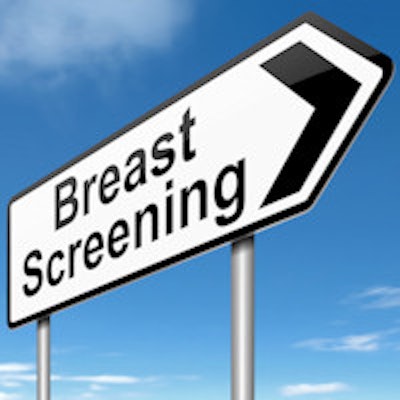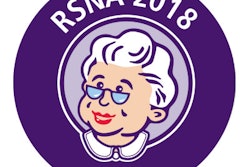
Even if it may detect slightly fewer noncystic lesions than handheld ultrasound performed by radiologists, automated breast ultrasound (ABUS) can still serve as an effective supplemental breast cancer screening tool in women with dense breasts, according to a multi-institutional research team.
In a prospective study involving nearly 300 patients with dense breasts, a group from Weinstein Imaging Associates in Pittsburgh and Northwestern University found a less than 8% difference in the detection of noncystic lesions between automated breast ultrasound and handheld ultrasound.
What's more, most of these additional lesions were not clinically significant, typically involving lesions that were classified as benign (BI-RADS 2) on handheld ultrasound. In addition, the ultrasound techniques yielded the same BI-RADS lesion classification grade in most cases.
As a result, automated breast ultrasound is a viable alternative, especially in certain situations, according to the group. For example, some institutions may prefer to have radiologists read these screening breast ultrasound studies separately and at different times from when they're performed, said Dr. Thomas Chang of Weinstein Imaging, a women's imaging center.
"That's an ideal situation [to use automated breast ultrasound], as well as if there's a limited availability of trained sonographers," Chang said.
He shared the findings during a presentation at the recent American Roentgen Ray Society (ARRS) meeting in Los Angeles.
Limitations of handheld ultrasound
Mammography has approximately 85% sensitivity for detecting breast cancer, but that performance dips to about 50% in women with dense breasts. This drop-off in sensitivity highlights the need for supplemental screening tools for dense breasts, Chang said.
"Ultrasound has become the primary supplemental test in dense breasts because it's widely available, costs less than the alternative, and uses no ionizing radiation," he said. "It's also quite effective."
In the landmark American College of Radiology Imaging Network (ACRIN) 6666 trial, handheld ultrasound performed by physicians on high-risk women detected four additional cancers per 1,000 patients over mammography alone. However, handheld ultrasound does come with limitations for supplemental breast cancer screening.
If physicians are responsible for performing these studies, they might also be busy with other tasks, Chang said.
"And the test can be time-consuming," he said.
In the ACRIN trial, handheld ultrasound took 19 minutes of physician time.
"If [the ultrasound studies are] performed by a technologist, the number of trained techs [in breast ultrasound] may not keep up with the demand, especially in areas where breast notification laws have increased demand for supplemental screening," Chang said.
A prospective comparison
As a result, the multi-institutional research team conducted a prospective feasibility study to compare automated whole-breast ultrasound with physician-performed handheld breast ultrasound in detecting noncystic lesions in women who were receiving supplemental cancer screening. The researchers evaluated 285 asymptomatic patients over 22 months who had a mammographic density rating of C (heterogeneously dense) or D (extremely dense) and a lifetime cancer risk of at least 10% under the Gail breast cancer risk assessment model.
All patients received handheld ultrasound and automated ultrasound studies on an Acuson S2000 automated breast volume scanner (AVBS) (Siemens Healthineers). The order of the exams was randomized.
Radiologists performed and interpreted the handheld ultrasound exams using a 3.8-cm, 18- to 6-MHz linear transducer, while a trained technologist performed the automated ultrasound studies with a 14.5-cm, 14- to 5-MHz linear transducer, Chang said. A different radiologist interpreted the automated ultrasound study on a dedicated workstation. All readers were experienced breast imagers; four were from Weinstein Imaging and five were from Northwestern University, Chang said.
He noted that both studies were interpreted in a blinded fashion independent of the current mammogram or other ultrasound study. Patient clinical history and prior studies were available, however.
After the readers decided on a BI-RADS score and management recommendation, the details of all lesions were entered into a computerized database. If there were more than four lesions, the four largest lesions were recorded, Chang said. One of the physicians then reviewed all of the exams and arrived at a final integrated BI-RADS assessment and recommendation.
The automated ultrasound study took an average 18.6 minutes of scan time, followed by 12.2 minutes of interpretation time. The handheld study required an average of 16.2 minutes.
"That may be a little bit longer than you may think, but we did have a strict protocol to adhere to and that did take some time," Chang said.
Of the 285 patients in the study, 198 (70%) had no lesions on either exam. The remainder had an aggregate of 137 lesions, all of which were benign.
Performance for visualizing lesions was as follows:
- Seen on both automated ultrasound and handheld ultrasound: 89/137 lesions
- Seen only on automated ultrasound: 19/137 lesions
- Seen only on handheld ultrasound: 29/137 lesions
As a result, handheld ultrasound detected 118 (86.1%) of the 137 lesions, while automated ultrasound visualized 108 (78.8%) of the lesions.
"Not that far off, but still a slight nod to handheld," Chang said.
Clinically significant differences?
The following lesions were missed by automated ultrasound:
- BI-RADS category 1 on handheld ultrasound: 0
- BI-RADS category 2 on handheld ultrasound: 25
- BI-RADS category 3 on handheld ultrasound: 1
- BI-RADS category 4A on handheld ultrasound: 2
- BI-RADS category 4B on handheld ultrasound: 0
- BI-RADS category 4C on handheld ultrasound: 1
The 25 misses in BI-RADS category 2 were not clinically significant, while the other four were all benign, Chang said.
Meanwhile, handheld ultrasound missed the following lesions:
- BI-RADS category 1 on ABUS: 0
- BI-RADS category 2 on ABUS: 4
- BI-RADS category 3 on ABUS: 9
- BI-RADS category 4A on ABUS: 3
- BI-RADS category 4B on ABUS: 3
- BI-RADS category 4C on ABUS: 0
"The 15 significant lesions [BI-RADS categories 3 and 4] were all benign as well," Chang said.
Rare mismatches
Relatively few cases yielded different BI-RADS scores between the two modalities. There were a total of 14 (10%) of these mismatched classifications for BI-RADS 3 (probably benign). Most of these were attributed to the automated ultrasound results.
Causes of BI-RADS 3 mismatches:
- BI-RADS 3 on automated ultrasound, but BI-RADS 1 on handheld ultrasound: 9
- BI-RADS 3 on automated ultrasound, but BI-RADS 2 on handheld ultrasound: 3
- BI-RADS 3 on handheld ultrasound, but BI-RADS 1 on automated ultrasound: 1
- BI-RADS 3 on handheld ultrasound, but BI-RADS 2 on automated ultrasound: 1
Four of the 12 BI-RADS category 3 mismatches were determined to be benign by the reader during reader integration of the two studies; one also had a fine-needle aspiration (FNA) biopsy. Seven were benign on follow-up and one had FNA biopsy that was benign. The two mismatches from handheld ultrasound were benign on follow-up, Chang said.
Ten cases (7%) were mismatched as BI-RADS 4 (suspicious). As was the case with the BI-RADS 3 mismatches, most were due to the automated ultrasound findings.
Causes of BI-RADS 4 mismatches:
- BI-RADS 4A on automated ultrasound, but BI-RADS 1 on handheld ultrasound: 3
- BI-RADS 4B on automated ultrasound, but BI-RADS 1 on handheld ultrasound: 3
- BI-RADS 4C on automated ultrasound, but BI-RADS 2 on handheld ultrasound: 1
- BI-RADS 4A on handheld ultrasound, but BI-RADS 1 on automated ultrasound: 2
- BI-RADS 4C on handheld ultrasound, but BI-RADS 1 on automated ultrasound: 1
Of the seven BI-RADS 4 mismatches due to automated ultrasound, three were found to be benign on core biopsy, two were determined to be benign on targeted ultrasound, one was judged to be benign during reader integration of the two studies, and one was benign on follow-up, Chang said.
The three BI-RADS 4 mismatches caused by handheld ultrasound included one case that was judged to be benign during reader integration, one that was benign on core biopsy, and one that was benign on FNA biopsy.
When considering both the 137 lesions and 198 patients who didn't have any lesions, the two modalities had matching BI-RADS scores in 305 (91%) of the 335 cases, he said.
"Clinically significant mismatches were relatively infrequent, but when they occurred, automated [ultrasound] had more false positives and more short-term follow-up recommendations," Chang said. "However, I would expect with time and experience that this difference should lessen."
He noted that further study is needed to assess differences in the detection of breast cancers and the effect of handheld scanning performed by technologists.
Study disclosures
Support for the study was provided by Siemens Healthineers.




















